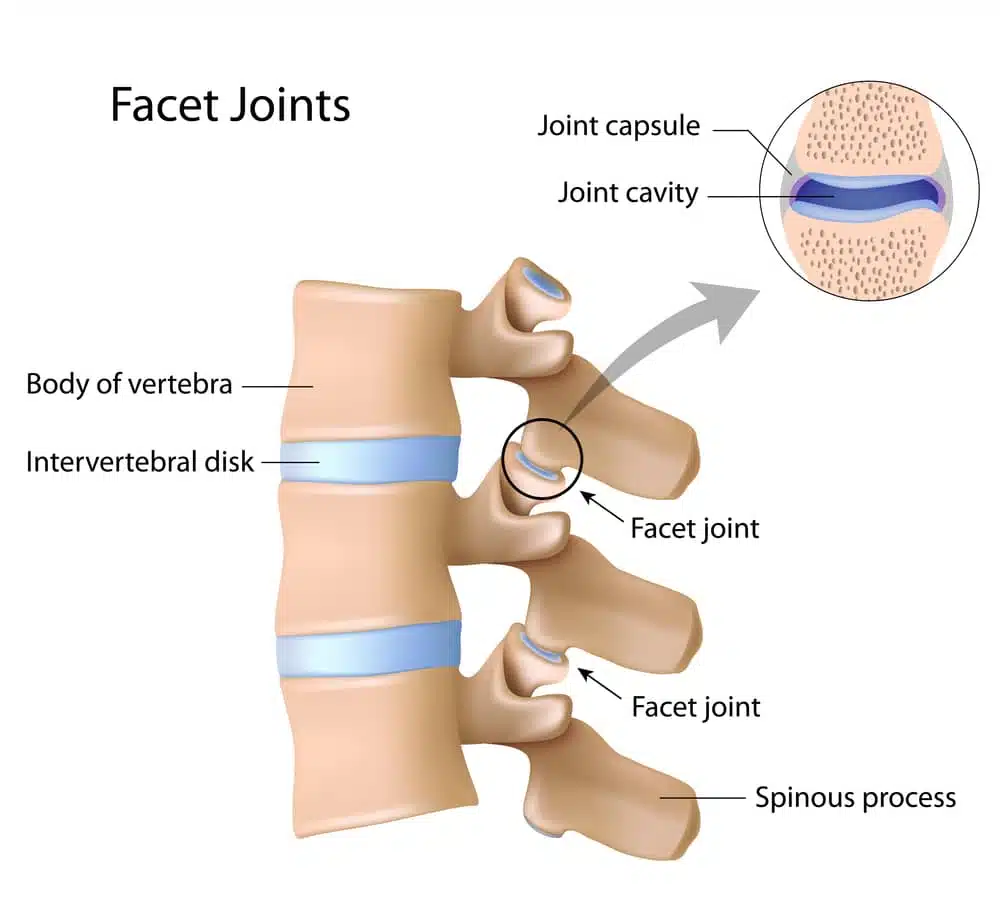What Patients Should Know About Facet Joint Syndrome

Did you know that about 15–45% of chronic low back pain cases stem from lumbar facet joint pain? Facet joint syndrome is one of the common causes of back pain and neck stiffness. Still, despite its prevalence, it remains an easily misunderstood condition.
Delayed facet joint treatment can lead to further complications. Facet joint degeneration can worsen, leading to spinal instability, bone spurs, and persistent radiating pain. Let’s explore what causes facet pain and the most effective treatments available.

What Are Facet Joints?
Facet joints are small synovial joints between each vertebra, acting as your spine’s natural shock absorbers. The two facet joints at each spinal level provide stability while allowing flexible movement, helping you bend, twist, and move without discomfort.
What Is Facet Syndrome?
Facet syndrome, or facet arthropathy, occurs when the spine’s stabilizing joints become inflamed, degenerated, or irritated. Depending on which area of the spine is affected, this condition is a leading cause of chronic low back pain and cervical facet syndrome.
So, what causes facet joint pain? Common causes of facet-mediated pain include:
- Facet joint osteoarthritis from natural wear and aging
- Spinal instability due to injury, repetitive motion, or sports injury
- Poor posture and spinal misalignment, increasing stress on the joints
- Degenerative disc disease, which alters spinal mechanics and accelerates facet joint degeneration
Symptoms of Facet Syndrome
Living with facet syndrome is not easy. The painful symptoms vary depending on whether the lumbar facet joints (lower back) or cervical facet joints (neck) are affected.

- Lower Back (Lumbar Spine) Pain: A dull ache or stiffness in your lower back that radiates to your buttocks or thighs.
- Neck (Cervical Spine) Pain: A nagging pain in your neck, headaches, or limited mobility that hinders everyday tasks.
The pain often follows a pattern and tends to worsen with movement. This is especially true when you twist your back or bend backward. However, relaxation can bring some relief. The pain subsides when you are lying down.
Since facet-mediated pain can mimic other conditions, like herniated discs, pinched nerves, or degenerative disc disease, a thorough physical examination and diagnostic tests (such as diagnostic medial branch blocks) are crucial for an accurate diagnosis.
How Facet Syndrome Is Diagnosed
An accurate diagnosis is crucial in managing facet syndrome. At Houston Spine & Rehabilitation Centers, here’s what you can expect from our diagnostic process:
- Knowing Your Symptoms. A thorough physical exam and symptom history analysis will help healthcare professionals better understand your condition.
- Diagnostic Imaging. Your healthcare provider may recommend diagnostic imaging tests like X-rays, MRI, and CT scans to confirm the diagnosis.
- Confirming the Source of Pain. Your healthcare provider will use facet joint injections to verify whether your facet joints are the source of your back pain.
A thorough consultation with healthcare professionals sets the stage for an accurate facet syndrome diagnosis.
Treatment Options for Facet Syndrome
Facet dysfunction can be managed and treated. Let’s explore some effective facet joint treatment options that help you find lasting pain relief.

Chiropractic Care
Chiropractors in The Woodlands use precise spinal adjustments to correct misalignments, relieve pressure on inflamed facet joints, and improve spinal function. These gentle adjustments can reduce facet pain while promoting natural healing without medications.
Physical Therapy
A customized physical therapy program strengthens your stomach and core muscles to better support your spine. Targeted stretches improve flexibility while reducing joint stiffness and muscle spasms associated with facet syndrome.
Epidural Steroid Injections
For severe facet joint pain, steroid joint injections deliver medication directly to the affected joint. This provides temporary pain relief by calming synovial inflammation and reducing pain signals to the spinal nerves.
Lifestyle Modifications
Making healthy lifestyle changes also helps manage facet syndrome. Simple adjustments like good posture, maintaining a healthy weight, exercising regularly, and managing stress can reduce symptoms and improve overall well-being.
Living with and Managing Facet Syndrome
To manage facet syndrome, focus on regular exercise, proper posture, and ergonomics, and avoid high-impact activities without professional guidance. With the help of our rehab professionals and local chiropractors in The Woodlands, you can prevent flare-ups with ongoing care.
Looking for Facet Joint Syndrome Relief? Get Started Today!
When facet joints are the source of discomfort, targeted treatment can make all the difference. Understanding what causes facet joint syndrome and recognizing symptoms early are crucial steps toward effective pain relief.
From physical therapy to facet joint injections, targeted treatments can alleviate pain and restore function. At Houston Spine & Rehabilitation Centers, we are experienced in precision diagnostics and personalized treatment plans for facet-mediated pain. Schedule your evaluation now!